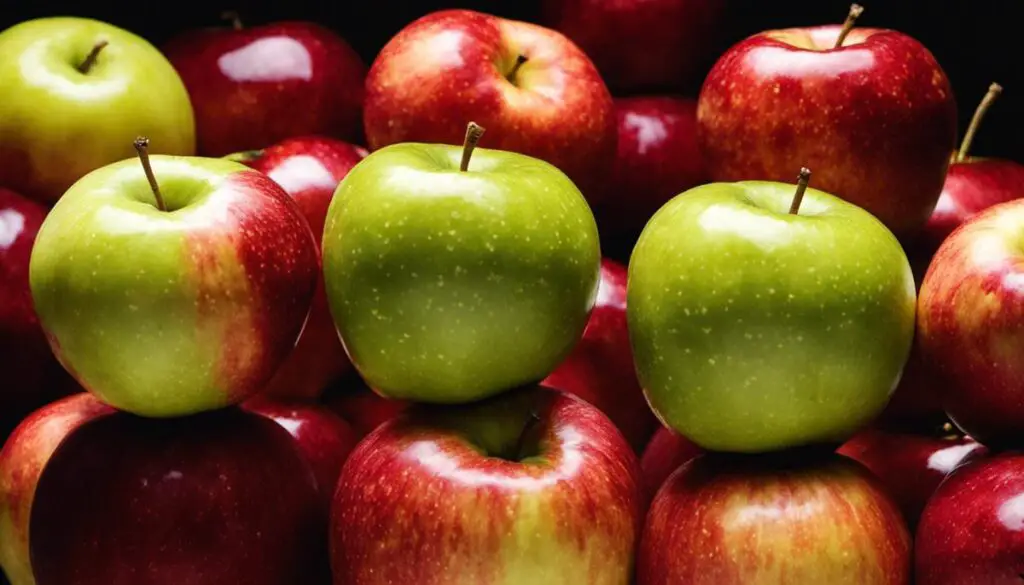Apples, hailed as a cornerstone of healthy diets across the globe, offer a plethora of essential nutrients. From a rich fiber content promoting digestive health, to an abundance of vitamins ensuring overall wellbeing, apples truly deserve their reputation as a powerhouse of nutrition. Yet, a question that often begs consideration is whether the condition of the apple, specifically when it turns mushy, impacts its nutritional value. Thoroughly understanding the causes behind apples becoming soft and overripe, may provide a comprehensive picture of the possible nutrient loss or alteration inherent in this process. Additionally, a comparative nutritional analysis of fresh versus mushy apples reveals crucial insights into their differing health benefits.
Understanding Apples’ Nutritional Value
Understanding the Nutritional Value of Apples
Apples are renowned for their high nutritional value. They are particularly rich in essential vitamins and minerals, including Vitamin C, Vitamin K, potassium, and several B-vitamins. Additionally, apples contain a significant amount of dietary fiber that aids in maintaining digestive health.
Most notably, apples are lauded for their antioxidant properties. They contain flavonoids and pectin, both of which contribute to their overall nutritional profile. Flavonoids are phytonutrients known for their antioxidant, anti-inflammatory, and anti-cancer properties. Pectin is a type of soluble fiber associated with reductions in cholesterol levels and improvements in gut health.
Do Mushy Apples Possess Lesser Nutritional Value?
Many people wonder if the nutritional integrity of an apple degrades as it transforms from firm and crisp to mushy and overripe. The ripening of an apple indubitably brings about alterations in its texture, appearance, and taste, as it becomes less acidic and more sweet.
While ripening does decrease the nutritional density in some fruits, it doesn’t impact all of an apple’s nutritional properties in the same way. For instance, research indicates that even though Vitamin C tends to decrease in overripe apples, the levels of many other nutrients remain stable.
Specifically, the fiber content of an apple does not deteriorate significantly over time. This means that you can gain the same quantity of dietary fiber from a mushy apple as you can from a fresher one. Even though water-soluble nutrients like Vitamin C could degrade, other nutrients, such as most antioxidants, remain consistent despite the change in the apple’s texture.
Intriguingly, it has been suggested that some antioxidants, especially quercetin, a flavonoid, might increase as the apple overripens.
However, it’s important to remember that a mushy apple could signify other alterations, like the onset of rot or mold. These conditions could lead to harmful bacteria and loss of nutrients.
To sum up, while there might be minor nutritional variations in overripe apples, it is not entirely accurate to claim they are less nutritious. They retain many of their health benefits and continue to be a nutritious addition to a balanced diet.

What Causes Apples to Turn Mushy
Why Do Apples Become Mushy?
When apples start to feel mushy, it typically indicates they’ve moved past their peak condition. This is a usual stage in the life cycle of an apple, which encompasses ripening and eventually reaching a state of decay. As apples ripen, the weakening of the pectin in the apple cells by an enzyme known as pectinase leads to a change in texture from firm to mushy.
Several external factors can expedite this process. High levels of heat and humidity can result in accelerated ripening, which is why apples are often kept in refrigerated conditions to extend their shelf life and maintain their crispiness. Moreover, rough handling can also cause bruising in apples, which quickens the degradation process, resulting in a mushy texture in the affected areas.
Nutritional Impact of Mushy Apples
As for the nutritional content, a mushy apple isn’t necessarily less nutritious than a fresh, crisp one. Minerals like potassium and vitamins like vitamin C remain largely unaffected in overripe apples. While the taste and texture may not be as appealing, much of the nutritional profile is preserved.
Yet, it’s essential to distinguish between mushy apples due to over-ripeness, and those that have actually started to rot. When apples rot, they can develop mold or produce harmful bacteria, which could lead to foodborne illnesses. In such cases, it’s not just a matter of nutrition but also food safety – and these apples should not be eaten.
Preserving Apples’ Nutrition
To make sure apples retain their freshness and full nutritional value for as long as possible, proper storage is vital. Apples should ideally be kept in a cool, dark place—like your refrigerator—to slow the ripening process. Also, apples should be handled with care to avoid bruising, which can lead to mushiness and subsequently, rotten spots.
Making sure to consume apples in a timely manner once they have been picked is another good method to ensure you’re getting the most out of their nutritional profile. This can be within a few weeks for apples stored at room temperature or a few months for those kept in a fridge.
Conclusion
To conclude, even when apples become mushy, they generally retain the majority of their original nutritional content unless they’ve started to rot. By practicing safe handling and maintaining appropriate storage conditions, the life-span of apples can be significantly extended, thereby keeping their nutritional content intact. Even though they may not have an appealing texture, overripe apples still remain a valuable source of nutrients. However, one must avoid apples showing signs of rot or mold as they could pose food safety risks.

Comparative Nutritional Analysis
Comparing Nutritional Content in Fresh and Overripe Apples
The nutrient composition of an apple changes as it goes through the ripening process and eventually turns mushy. Freshly picked apples are typically nutrient-dense, packed with vitamins and minerals, including Vitamin C, certain types of Vitamin B, and several antioxidants. On top of that, apples are rich in dietary fiber, specifically soluble and insoluble fiber, which is vital for optimal digestive health. For instance, a medium-sized, just picked apple usually provides around 4.4 grams of dietary fiber.
The Nutrient Breakdown of Mushy Apples
As apples age, their appearance and texture change. Initially, they soften, and if left at room temperature, they may eventually become mushy. Interestingly, when an apple becomes mushy, its sweetness intensifies. This is due to the conversion of starches to sugars in the process of ripening and beyond.
Though the sweet, overripe taste might be appealing to some individuals, it’s important to note that while the sugar content increases, the nutritional value of the apple decreases. Overripe or mushy apples tend to lose some of their nutrient content, especially Vitamin C, which is sensitive to heat and light. Despite the loss of some nutrients, overripe apples still retain a considerable amount of dietary fiber. However, the levels of soluble and insoluble fiber might lower compared to their fresh counterparts.
Are Mushy Apples Less Nutritious?
The nutritional analysis of apples clearly shows some deterioration in nutrient content as apples overripen and become mushy. Vitamins, particularly Vitamin C, are significantly diminished as these fruits pass their peak ripeness. However, it’s important to note that while mushy apples may lose some nutritional content, they are not void of nutritional benefits completely. Dietary fiber, for instance, remains a significant component of overripe apples, albeit at a mildly reduced amount.
Therefore, while mushy apples may be less nutritious than fresh apples in terms of certain vitamins and nutrients, they still contribute to a healthy diet by providing dietary fiber. It’s also worth noting that the softened texture of overripe apples can be an advantage for individuals who have difficulty chewing or swallowing, making the fruit more accessible to consume.
Understanding the right balance and moderation in your diet is important, as different types of fruits, including apples in varying states of ripeness, each offer distinctive nutritional benefits. Rather than being a definitive measure of apple’s nutritional content, its texture – whether it is fresh or mushy – is simply one aspect to consider when looking at the wide spectrum of nutrients that an apple can provide.

Interpreting the Impact on Health
Digging Deeper into Apple’s Nutritional Values
Known as a nutritional powerhouse, apples boast a rich content of dietary fiber while being low in calories with no traces of fat, sodium, or cholesterol. Their high levels of antioxidants and vitamin C are crucial for maintaining good overall health. Furthermore, apples are home to a moderate amount of potassium, vitamin K, and a handful of B vitamins, enhancing their food value.
Nutritional Changes in Mushy Apples
As apples begin to deteriorate and become mushy, they undergo compositional changes that affect their nutritional value. During the ripening process, apples undergo a transformation in their organic compound complex. They create new compounds, break down others, and convert some into different forms. As the apple becomes mushy, it is essentially overripe and over-ripeness in fruits has been associated with an increase in antioxidants. However, this does not mean that mushy apples are healthier.
Interpreting the Impact on Health
Mushy apples, which are overripe apples, may contain slightly more antioxidants. But very mushy or rotten apples could potentially lose their vitamin C content, as this nutrient is sensitive to air, light, and heat. Additionally, overripe and especially rotten apples can harbor harmful bacteria and molds. This could lead to foodborne illness if the apple is not properly handled and consumed.
For individuals who consume apples primarily for their health benefits, it’s essential to eat fresh and ripe apples for optimal nutrient intake. If the apple has become too mushy and shows signs of rotting, it’s best to discard it. Consuming rotten fruit not only offers less nutritional value but also poses health risks.
The Impact of Storage Conditions
Storage conditions greatly impact the nutritional quality and safety of all fruits including apples. Apples should ideally be stored in a cool, dry place to maintain their firmness and prevent over-ripening. Overripe apples, while still safe to eat, produce ethylene gas that can speed up the ripening process of other fruits and vegetables. Over-ripening also leads to changes in texture and flavor profiles, often making them less appealing to eat.
Conclusion
While mushy or overripe apples might have a slight increase in antioxidants, the potential nutritional losses, and health risks linked to consuming very overripe or rotten apples overshadow this small benefit. It is recommended to consume fresh, ripe apples for the best balance of taste, texture, and health benefits.

As we explore the implications of consuming mushy apples in contrast to their fresh counterparts, there is an undeniably complex interplay between texture and nutrition. The ripening process, coupled with environmental factors, shape the nutritional profile of apples in ways that can either uphold or slightly diminish their health benefits. Therefore, while apples remain a remarkable source of vital nutrients irrespective of their physical state, the reality of some potential nutritional changes cannot be disregarded. This acknowledgment does not outright discourage the consumption of overripe apples, rather, it invites a more informed approach to apple consumption, especially for those who rely significantly on this fruit for its health benefits.
